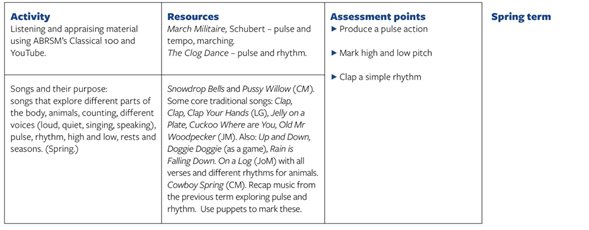
I first started teaching reception age children music back in 1990 as a student volunteer in a Manchester primary school (in return, the head allowed me to use the school piano to practice on). Working with this age of children has always been a magical experience for me. This is when a love of music can be ignited and musical skills developed for success in future years.
For the past five years I have taught reception music at Osbaldwick Primary in York (part of Ebor Academy Trust). I am lucky that the school has always made this an essential part of the curriculum. I share here some of my most recent work as a full-year example music curriculum for reception. Teachers can adapt it for their own settings.
What to include in a reception music curriculum?
Up to the age of five (the end of that academic year) children have a specific curriculum that reflects the ways in which this age group learns. Any reception music curriculum needs to cover these prime areas along with the other supporting areas. Teachers must also provide material that allows for characteristics of effective learning.
The statutory framework for the Early Years Foundation Stage (March 2017) lists three prime areas: communication and language; physical development; and personal, social and emotional development. These prime areas are supported by teaching in the areas of literacy, maths, understanding the world, and expressive arts and design.
Three characteristics of effective teaching and learning for this age group are:
- Playing and exploring – children investigate and experience things and ‘have a go’
- Active learning – children concentrate and keep on trying if they encounter difficulties, and enjoy achievements
- Creating and thinking critically – children have and develop their own ideas, make links between ideas, and develop strategies for doing things.
To prepare students for future music lessons, I also keep in mind the music national curriculum for children Year 1 and beyond: ‘Perform, listen to, review and evaluate music across a range of historical periods, genres, styles and traditions, including the works of great composers and musicians.’ So my added focus areas are performing, listening and reviewing, and I also add composing.
The main elements of our school reception music curriculum can be categorised into:
- Singing throughout the day
- Individual solo performance (the singing chair)
- Performances throughout the school year
- A 30-minute weekly music lesson delivered by a specialist following a planned curriculum with traditional song and rhyme at its heart.
Singing throughout the school day
This can aid communication and language; personal, social and emotional development; and expressive arts. An easy way to do this is bringing music into key classroom activities. Here are some ideas:
Singing the register and singing goodbye
Sing the register to a minor third – eg F D F D, ‘Hello Jamie’. A goodbye rhyme (invite the children to tick their finger backwards and forwards to the pulse as they say it):

Tidy up song.
You can use these words and fi t them to Frère Jacques: ‘Are you helping, are you helping, tidy up, tidy up, let us all be helpers, let us all be helpers, as a team, as a team.’ [Karen Marshall]
Lining up song.
These words fit with the tune Hot Cross Buns: ‘Please line up, please line up, quietly and sensibly now, please line up.’ [Karen Marshall]
Children can also be encouraged to sing in the playground with traditional playground clapping games.
Individual solo performance
Again, this aids communication and language as well as personal, social and emotional development. Children can really thrive on those special moments where parents, carers and other family members see them shine. I also provide weekly opportunities for solo performance with children singing solo in songs or demonstrating actions, or even improvising actions.
The singing chair.
I've used this idea for years, as have many other practitioners. It's simply a good idea. Cyrilla Rowsell and David Vinden regularly use this concept throughout their superb Jolly Music books (Jolly Learning). The children get to sing on a special chair. I use the class teacher's chair, but I know some teachers drape special fabric over a normal chair. Children sing any song they wish. We tend to video this for assessment evidence. We also encourage the song to be the child's own made-up one or, if the child is from a different country, a song in their native tongue.
Performance throughout the year
Throughout the school year there are key dates that lend themselves to performance. Here are some example programmes of performances we've presented at our school in previous years.
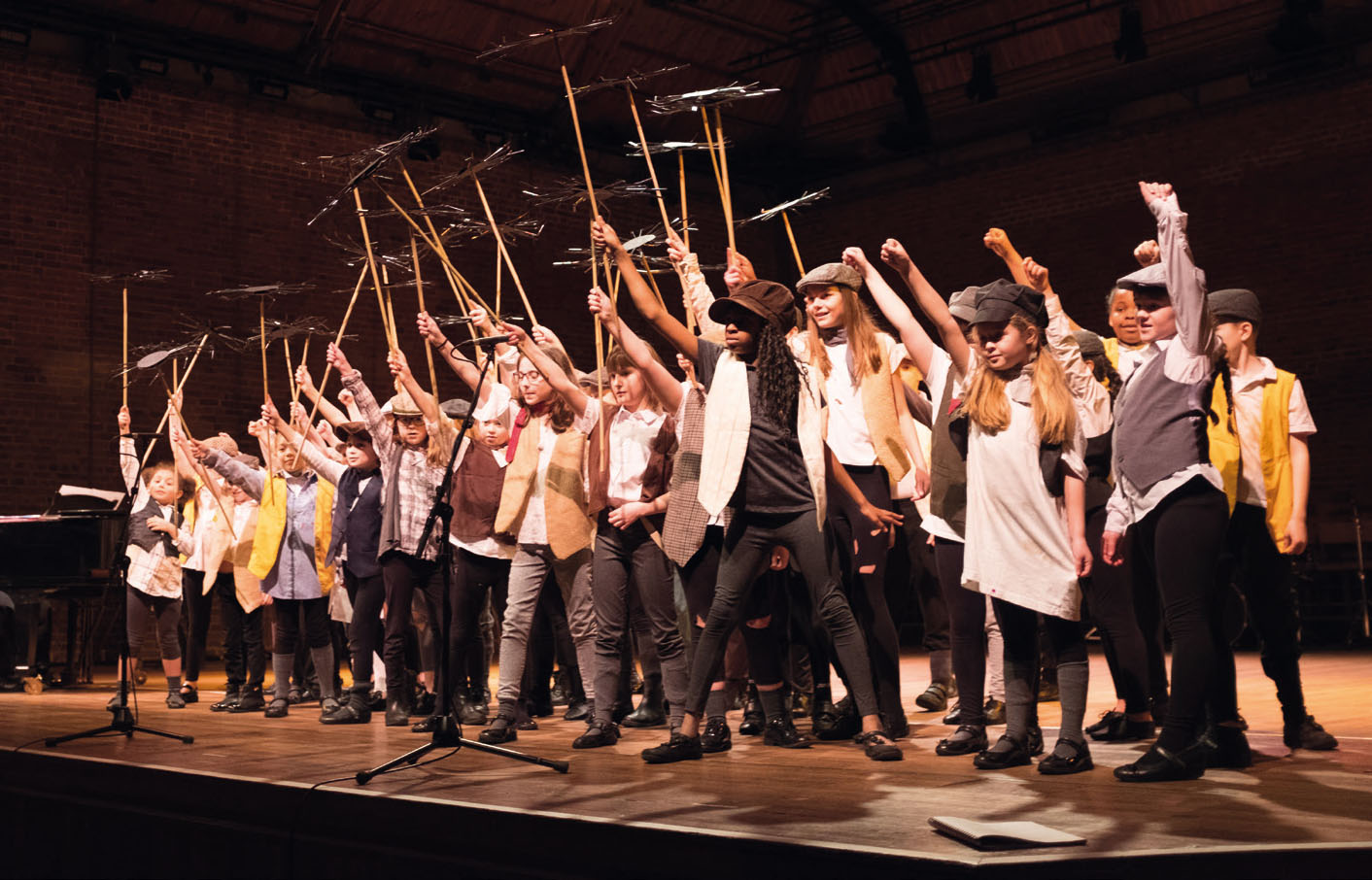
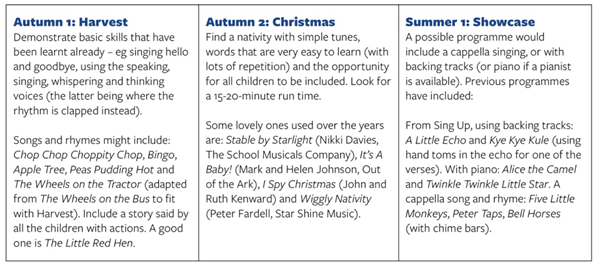
The weekly music lesson
In this lesson, all songs and materials should link with the early years prime and supported areas.
Communication and language (plus literacy):
Songs include lots of traditional rhyme, and words of songs are also shown written down where accessible and appropriate. Improvising ideas (eg for new verses) are asked for as extension activities. Listening skills are promoted through questioning.
Physical development:
A number of songs and rhymes include actions, requiring coordination. Actions might be making a circle or improvising a body action (eg making up an action for the pulse) or using a ball or beanbag.
Personal, social and emotional development:
Turn-taking is required, sitting quietly on the carpet and putting hands up for questions. Also, describing feelings about music as happy, sad, exciting and so on.
Mathematics:
Use of songs that include number.
Understanding the world:
Songs and rhymes linked with nature and the seasons.
Expressive arts and design:
Encouraging children to make up their own song on the singing chair.
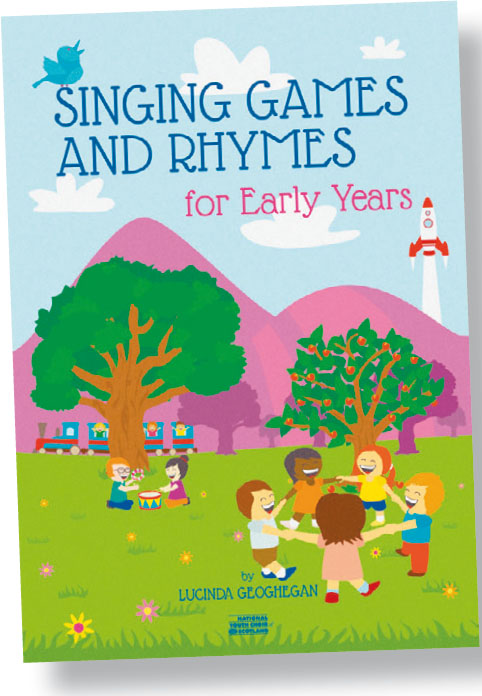
I use a Kodály-based approach of ‘preparation, presentation and practice’. Each concept of learning is prepared (put in the subconscious), presented (shown the musical concept), and practised (repeated in lots of different contexts). A useful summary of the approach is provided in The Music Handbook (Jolly Music), which also explains the value of a singing-based music curriculum in the early stages that also develops inner hearing and listening along with core musicianship skills such as pulse, pitch and rhythm.
Early years resource shelf
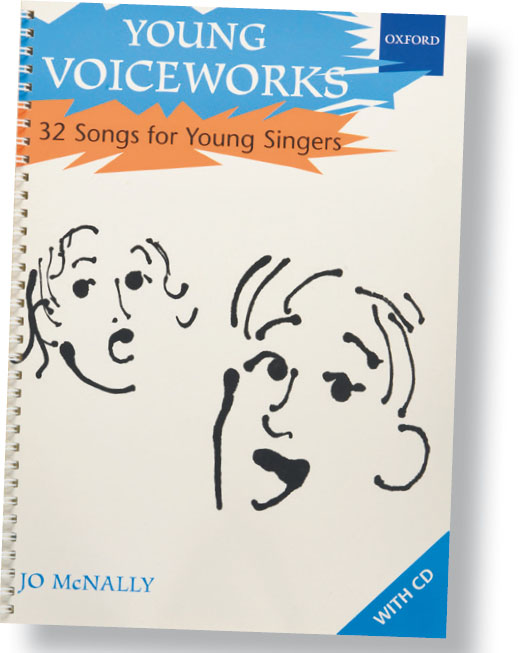
The following resources are my staple set of resources for early years music, and I refer to them in the tables that follow.
- The Music Handbook, Beginners (Cyrilla Rowsell and David Vinden, Jolly Music) (JM). This follows a Kodály approach. Look out for the accompanying ‘Big Book’ so song words can be used with the children.
- Hello Children: A Collection of Songs and Related Activities for Children Aged 4-9 (Shirley Salmon, Schott) (SS). This book follows an Orff approach.
- Singing Games and Rhymes – Early Years (Lucinda Geoghegan, NYCoS) (LG) Uses a Kodály approach.
- Inside Music – First Steps: Age 5-7 (Andrew Maddocks, Alfred) (AM).
- Young Voiceworks – 32 Songs for Young Singers (Jo McNally, Oxford) (JoM).
- Sing Up (resources available by subscription) (SU).
- Classical 100 (ABRSM, free subscription for any UK primary school) (AB).
- I love Music (Out of the Ark Music) (OotA).
- Harlequin – 44 Songs Round the Year (Collins Music) (CM).
- Musication (YouTube channel). Various music percussion ensemble pieces using classical music. This is so good I even donate to it on Patreon!
- Generic items: claves, sponges to squeeze to the pulse, chime bars, hand toms, puppets (hand and fi nger), rhythm fl ashcards.


